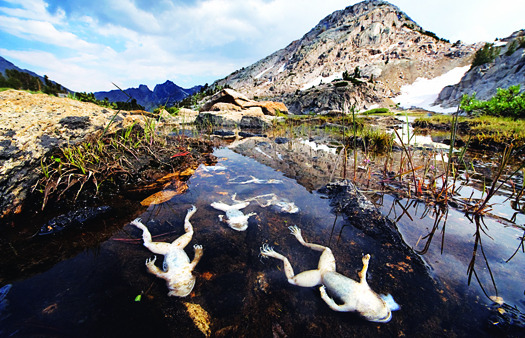

A tiny frog with an impressive snout has been discovered in the Peruvian Amazon, scientists reported this week.
The frog makes its home in the basin of the Putumayo River, which runs through Colombia, Ecuador, Peru, and Brazil. Researchers found the new species during a 2019 expedition to learn more about the basin’s mysterious amphibian residents. The frog’s most distinctive feature is a long, protruding snout resembling that of a tapir, a pig-like, hoofed mammal with a distinct trunk. The shape of the frog’s schnoz may hint at a life spent nosing through soft, wet soils.
The newly-recognized amphibian is also a smooth, rich brown in color. “It looks like it was made from chocolate,” says Germán Chávez, a herpetologist at Peru’s Instituto Peruano de Herpetología who is based in Sheffield, England.

The team was only able to capture three of the tapir frogs. Much remains to be learned about the species, including its range and population status, says Chávez, who described the new frog on February 16 in the journal Evolutionary Systematics.
The first tapir frog he spotted was a young male less than a third of an inch long. Several nights later, the researchers heard a high-pitched beeping coming from beneath the ground, which led them to two slightly larger adult males. When the team analyzed the frogs’ anatomy and genetic material, they confirmed that the amphibians were a previously unreported species belonging to a group known as disc frogs. Disc frogs spend a lot of time underground, making them difficult for scientists to detect and study.
Chávez and his collaborators were guided to the frogs’ moist habitat by guides from Peru’s Comunidad Nativa Tres Esquinas. The first time that local people and several of the researchers saw one of the frogs, they referred to it as “rana danta”—the Spanish terms for “frog” and “tapir,” respectively. “When we found these individuals, they mentioned, ‘Oh there’s one of those tapir frogs,’” Chávez recalls. He and his colleagues named the new species Synapturanus danta in honor of the long-nosed mammals, which mostly live in the forests and grasslands of Central and South America.
Most disc frogs have a bulky body and broad snout that helps with burrowing into the soil, while the tapir frog has a more slender frame. “The danta frog is not prepared to dig very hard because the body shape is not robust enough,” Chávez says. However, its body is perfectly suited to the soggy and loose soil of the peatlands in which it dwells. In this type of wetland, the damp conditions cause partially-decayed plant matter called peat to accumulate. Chávez and his colleagues observed the tapir frogs in the shallow spaces beneath the roots of small trees growing from the least waterlogged patches of peat.
A team of Peruvian herpetologists has recently identified another group of frogs elsewhere in the Putumayo basin that may turn out to be the same species, he says. If this population can be confirmed as tapir frogs, they could give scientists more information about the species’s distribution and how best to conserve it.
The Putumayo is the only remaining Amazon tributary with no existing or proposed dams, the researchers noted in the paper. Currently, the area where the species was discovered has not been heavily affected much by habitat destruction. However, the amphibians could help researchers understand how this wetland ecosystem is responding to deforestation or climate change in the future.

The next step, Chávez says, will be to determine whether the tapir frog is restricted to the peatlands. “If we could prove that this frog is a peatland specialist…we could consider the danta frog as an indicator of a healthy peatland,” he says.
The variety of approaches the researchers used, which included anatomical observations, genetic data, and audio recordings, strengthens their conclusion that the tapir frog is a new species, says Anne Chambers, an evolutionary biologist at the University of California, Berkeley, who wasn’t involved in the research.
“In terms of this region, we know that there’s a lot of undescribed species and undescribed diversity in that part of the world,” she says. “It’s important for us to try to efficiently describe these species in a scientific and reliable way.”















